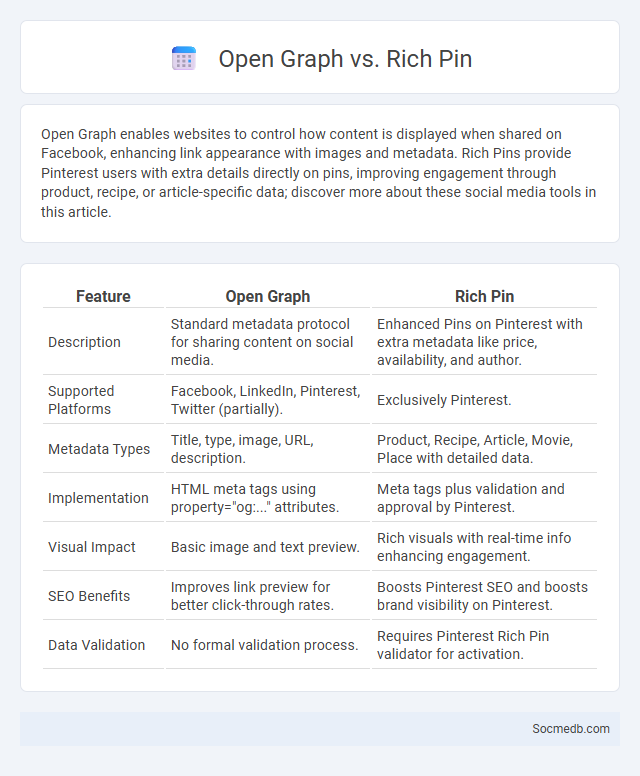
Photo illustration: Open Graph vs Rich Pin
Open Graph enables websites to control how content is displayed when shared on Facebook, enhancing link appearance with images and metadata. Rich Pins provide Pinterest users with extra details directly on pins, improving engagement through product, recipe, or article-specific data; discover more about these social media tools in this article.
Table of Comparison
| Feature | Open Graph | Rich Pin |
|---|---|---|
| Description | Standard metadata protocol for sharing content on social media. | Enhanced Pins on Pinterest with extra metadata like price, availability, and author. |
| Supported Platforms | Facebook, LinkedIn, Pinterest, Twitter (partially). | Exclusively Pinterest. |
| Metadata Types | Title, type, image, URL, description. | Product, Recipe, Article, Movie, Place with detailed data. |
| Implementation | HTML meta tags using property="og:..." attributes. | Meta tags plus validation and approval by Pinterest. |
| Visual Impact | Basic image and text preview. | Rich visuals with real-time info enhancing engagement. |
| SEO Benefits | Improves link preview for better click-through rates. | Boosts Pinterest SEO and boosts brand visibility on Pinterest. |
| Data Validation | No formal validation process. | Requires Pinterest Rich Pin validator for activation. |
Introduction to Social Media Metadata
Social media metadata encompasses information embedded in posts, images, and videos that describe content attributes, such as timestamps, geolocation, user tags, and hashtags. This data plays a critical role in content discovery, personalization algorithms, and targeted advertising across platforms like Facebook, Instagram, and Twitter. Efficient use of social media metadata enhances engagement metrics and improves the accuracy of sentiment analysis and audience insights.
What is Open Graph?
Open Graph is a protocol developed by Facebook that enables web pages to become rich objects in social media sharing, enhancing how your content appears on platforms like Facebook, Twitter, and LinkedIn. By using Open Graph tags, you can control the title, description, image, and URL that populate when your web page is shared, improving engagement and click-through rates. Implementing Open Graph ensures your social media posts display consistently and attractively, boosting visibility and user interaction.
Overview of Rich Pins
Rich Pins enhance social media by embedding extra information directly on posts, improving user engagement and content discovery across platforms like Pinterest. These pins come in several types, such as product, recipe, and article pins, each displaying tailored details like real-time pricing, ingredients, or headlines. By leveraging metadata from websites, Rich Pins provide a seamless shopping and browsing experience, increasing click-through rates and boosting organic reach.
Differences Between Open Graph and Rich Pins
Open Graph is a protocol developed by Facebook that enables web pages to become rich objects in social media, allowing customizable previews with titles, images, and descriptions when shared. Rich Pins, specifically used on Pinterest, provide more detailed information directly on the pin itself, such as product pricing, availability, or recipe ingredients, enhancing user engagement. Understanding these differences helps you optimize your content for each platform's unique sharing features and improve your social media presence.
Key Features of Open Graph
Open Graph enables social media platforms to display rich previews when you share links, enhancing engagement with titles, descriptions, and images. Its key features include customizable metadata tags like og:title, og:description, and og:image, which control how content appears across networks. By implementing Open Graph tags, your shared content becomes more visually appealing and clickable, increasing reach and interaction.
Essential Features of Rich Pins
Rich Pins on social media platforms enhance user engagement by displaying extra information directly on the pin, such as product details, prices, and availability, improving the shopping experience. These pins automatically update metadata, ensuring content stays current and accurate without manual edits. Integration with platforms like Pinterest allows businesses to boost visibility and drive traffic through visually rich, actionable posts.
Use Cases: Open Graph vs. Rich Pins
Open Graph enables websites to control how their content appears on social media platforms by defining metadata such as title, image, and description, enhancing link previews and driving higher engagement rates. Rich Pins, used primarily on Pinterest, provide deeper context by pulling real-time information like pricing, availability, or event details directly into the pin, boosting click-through rates and purchase conversions. Both Open Graph and Rich Pins improve user interaction but serve distinct use cases: Open Graph optimizes broad social sharing across multiple platforms, while Rich Pins enrich product, recipe, and article experiences within Pinterest's ecosystem.
Implementation: How to Add Open Graph
To add Open Graph to your social media strategy, incorporate specific meta tags into the HTML header of your web pages, defining the title, type, image, and URL to control how your content appears on platforms like Facebook and LinkedIn. Use properties such as og:title, og:description, and og:image to ensure that your links display rich, engaging previews that increase click-through rates and user interaction. Testing the implementation with tools like Facebook's Sharing Debugger helps identify and fix errors before your audience encounters the content.
Setting Up Rich Pins for Pinterest
Setting up Rich Pins for Pinterest enhances your social media presence by automatically syncing detailed product, recipe, or article information directly from your website to your pins. You need to apply for Rich Pins through Pinterest, verify your website, and implement the appropriate meta tags or Open Graph tags to enable this feature. By utilizing Rich Pins, your content becomes more engaging and discoverable, driving increased traffic and conversions through Pinterest.
Choosing the Right Metadata for Your Content
Choosing the right metadata for your social media content significantly impacts its visibility and engagement across platforms like Instagram, Facebook, and Twitter. Optimizing hashtags, descriptions, and titles with relevant keywords ensures your content reaches the target audience effectively. By strategically using metadata, you can enhance your content's discoverability and drive more interaction from your followers.
 socmedb.com
socmedb.com